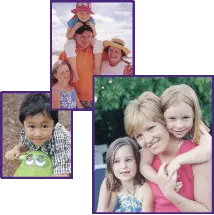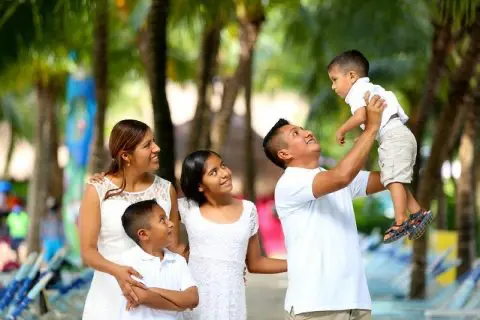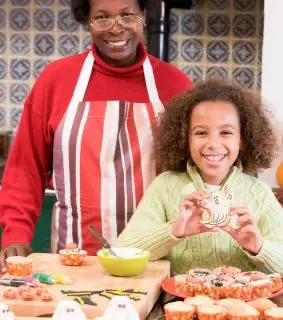Talking to Children About Terrorism and Armed Conflict
by Judith A. Myers-Walls
War is devastating to children.In the past decade, UNICEF has estimated that
more than three million children have been killed in armed conflict.At least six million have been seriously injured
or permanently disabled . Although
the impact on those children who live in war zones is most severe and damaging,
there are consequences for children all over the world, whether they become
aware of and concerned about the conflict or not (Myers-Walls).
p>The events of September
11, Mumbia, Beirut and Paris and many others, provide a unsettling lesson on the impact
of violent conflict on children for many parents and teachers.Although the attacks appear to have been confined
to a limited number of pl and lasted only a short time, people across
the world felt and continue to feel threatened and vulnerable.Because of the number of people killed or injured
that day, a very large number of people had direct connections with the death
and destruction. Children were aware
of the tragedy, so parents needed to respond. Families are extremely important systems and
constitute the most important unit for post-disaster
treatment and intervention efforts (Norris et al. 2001b, 5).Yet, as a cartoonist once wrote, War is never
so ugly as when you explain it to children.
Adults could not pretend that the children did not know about this
event, but they felt unprepared and, as one parent put it, completely taken
aback about how unequipped we are talk about this.
After several terror atacks, many organizations
and individuals responded to the need for information for parents and teachers
by using a wide variety of media. The
concentration on children's needs and reactions seems to be unprecedented
and is probably linked to the immediacy of people's exposure to the event
due to mass media coverage and the fact that the attack was at home.
Research supports some approaches that are
likely to be effective when talking with children about terrorism and armed
conflict, although this topic needs additional research.It also is a topic closely tied to religious
and political attitudes and to assumptions that may or may not be related
to developmentally appropriate practice. Family
life educators can play a valuable role in helping parents and teachers to
understand their own reactions and attitudes, to support children at times
of national trauma, and to build positive skills and attitudes for the future.
Help children deal with initial reactions
Mass media make tragedies and disasters present and real almost everywhere
around the world immediately after they occur.Some children watched the events of September
11 all day at school with no interpretation or explanation.Even children who had only
minimal contact with the event had questions and were confused.This is true of children's understanding of
many wars and international conflicts (Myers-Bowman, Walker, and Myers-Walls
2000). Since September, children as young
as 2 have learned to connect planes
with crashing into buildings, even if their parents thought those children had
no exposure to the event.
There are special risks when entire families are traumatized.
As one parent asked, How do I explain it to the children when I
don't understand it myself? This response seems to be consistent with responses
of parents who feel vulnerable and under attack (Myers-Walls).
A danger in those situations is that a cycle of silence can result.
Children have a natural tendency to try to get back to routine and
normal life as soon as possible. They
look for something predictable and familiar.
Children also may show delayed reactions to trauma. When they do either of those things, though,
adults may interpret the reaction to mean that the children are not upset.When the adults are also traumatized, they are
relieved that the children seem to be doing okay.They avoid bringing up the trauma.When the children are ready to talk, they see
that the parents don't want to talk about it.
The result is that both parents and children do not deal adequately
with their stress and trauma (Dyregrov).
Because of the dangers of the cycle of silence, parents
need to communicate to the children that they are willing to talk about
the stressful event and about the family's reaction to it.It is not necessary to give a lecture or provide
a long list of facts, but children need to know that they can talk to their
parents or other supportive adults. They
need to talk about feelings and begin to understand events.Misunderstandings can be problematic. Related to the events of September 2001, one
five-year-old confused the words hijacker and kayaker.The only way parents can deal with such misunderstandings
is by listening to and talking with their children.
Reassure children, but be honest
Terrorism is designed to make people afraid.Because children have limited information, skills,
and experience, they are likely to feel especially afraid (Norris et al.
2001a, 2001b). Parents and other
caring adults can help to reassure those children and reduce their fears.It is difficult to be reassuring when the adults
are also feeling afraid, though. It
might not be convincing to the children if the adults tell the children
that nothing bad will happen. Parents
who promise that nothing bad will happen also risk losing the children's
trust and making them feel betrayed when those children learn that the parents
cannot control all outcomes.
Adults can, however, reassure children that adults will
do everything they can to keep the children safe.
The adults can then describe the safety precautions they are taking.
This is honest and realistic, and often this is the reassurance that
children need.It also is appropriate to introduce religious
beliefs at times like this. Beliefs
about the meaning of life and death and about the presence of a higher being
may be more meaningful at times of trauma.
Children have other emotions
During times of trauma, children are often afraid, and
it is appropriate to deal with those fears.
Previous attempts to help children through times of trauma have often
stopped there, however. Studies of
children after the Persian Gulf War showed that children did have fears,
but those studies also revealed other responses.
After fears, the next most common reactions among a sample of children
at that time were sadness and anger. The
children were not only concerned about their own safety and well-being;
they were also sad that other people were being killed and that children
were losing parents. They were angry
that some people had decided to fight instead of working out their problems
(Myers-Walls 1991).
Adults should try to identify the feelings
of children that go beyond fear for their own safety.
Caring about the well-being of others is an important pro-social
emotion related to the development of nurturing behavior.Adults can build on that emotion by helping
children to explore ways that they can care for others.
It also is helpful if parents validate
a wide range of feelings in their children, including uncomfortable ones.Parents may wish they could protect their children
from fear, anger, and sadness, but such protection is both impossible and
not helpful. Children benefit from
learning that all emotions are legitimate and then learning positive ways
to express those feelings. Parents
who admit their own uncomfortable feelings can model for the children some
positive methods for coping with those feelings.
The better the parents learn to manage their own feelings, the better
the children will cope (Norris et al. 2001c).
Take action with children
People who feel helpless and out of control
will feel stress more acutely than those who have a sense of self-efficacy
(Norris et al. 2001c).After a stressful or traumatic event, it is
helpful for both parents and children to take some kind of action to help
to put their world back in order. For
younger children, this may mean acting out the traumatic events through
play and drawing pictures. For adolescents,
writing letters to the editor of the paper or collecting funds for people
in need may be helpful. Parents can
help to guide children to an action that is appropriate for the child, the
family's belief system, and the community.
It is important for parents to take action as
well.Children who see their parents take action are
likely to learn that there is hope and that it is possible to be optimistic
about the future. Hope and optimism
are powerful coping tools (Norris et al. 2001c).
Seeing parents take action can also increase children's feelings
of security and safety. In a practical
sense, parents and children who take action are also making future human-caused
traumas less likely.
Reduce violence in children's lives
Being victims of violence can increase a person's sensitivity to other violent
acts. Feelings of fear and threat impact
lower levels of the brain, and continued exposure to those emotions can change
the actual chemistry of the brain, making higher level thought less likely
and more difficult (Perry 1997). Continued
exposure to violence also carries the risk of re-traumatizing a child (Figley
2001).
Parents and teachers should monitor exposure
to media and limit continual repetitions of the traumatic event in sound
and pictures.They also should monitor play activities and
toys. Activities that may have felt
appropriate and neutral in the past may now be uncomfortable and stressful.Parents also should become aware of their own
use of violence when interacting with children.
Traumatized children will not benefit from harsh punishment.Harsh punishment also appeals to lower levels
of the brain. Both parents and children
will function better if they use reasoning, discussion, and problem-solving
in their interactions with each other.
Teach about peace
Researchers have found that parents say more to their children about war than
peace, and they use more action-oriented terms to do so (Myers-Walls, Myers-Bowman,
and Pelo 1993).During times of international conflict and war,
children are exposed to many violent methods for solving problems.Most parents would prefer that their children
learn to use constructive, nonviolent methods.
In order for them to learn those skills, parents need to increase their
own knowledge of alternatives, expose children to nonviolent role models, and
discuss alternative options when conflict occurs (Myers-Walls and Myers-Bowman
1999).
Family life educators can help to build these
skills
All of the approaches listed above are skills that can be
strengthened through effective family life education.Educators can help parents and teachers to monitor
their own feelings and behaviors, to communicate effectively, to recognize
children's reactions, to support children's emotional and intellectual development,
to monitor children's play and media exposure, and to foster peacemaking skills.
Family life educators can help parents, teachers, and children to minimize
the trauma and maximize the positive learning experience.
References
Dyregrov, Atle.1992. Work
with traumatized children: Psychological effects and coping strategies.
Journal of Traumatic Stress 5:5-17.
Figley, Charles.2001. The
role of major life trauma in everyday life.
Presented at the Annual Council on Family Relations,
Rochester, NY.
Myers-Bowman, Karen S., Kathleen Walker,
and Judith A. Myers-Walls.
2000. Children's reactions to international conflict:
A cross-cultural analysis. Presented
at the Annual Meeting of the National Council on Family Relations, Minneapolis, Minn.
Myers-Walls,
Judith A. 1991. Parents, children, and the Persian Gulf war. Presented
as part of the symposium "Operation Desert Storm: Impact on the Home
Front" at the Annual Meeting of the National Council on Family Relations,
Denver, Colo.
Myers-Walls, Judith A., and Karen S.
Myers-Bowman. 1999.Sorting through parenting education resources:
Values and the example of socially conscious parenting.
Family Science Review 12:69-86.
Myers-Walls, Judith A., Karen S. Myers-Bowman,
Kathleen Walker, and Roshan Khosravi. 2000.
Passing on the peace: Parents and
children describe war and peace.
Presented at the Annual Meeting of the National
Council on Family Relations, Minneapolis, Minn.
Myers-Walls, Judith A.
2001. The parents' role in
educating about war and peace. In Judith Myers-Walls, Péter Somlai, and Robert Rapoport (Eds.).
Families as educators for global citizenship.Altershot:Ashgate.
Myers-Walls, Judith
A., Karen S. Myers-Bowman, and Ann E. Pelo. 1993.Parents as educators about war and peace.
Family Relations 42:66-73.
Norris, Fran H., Christopher
M. Byrne, Eolia Diaz, and Krzysztof Kaniasty.2001a.The range, magnitude, and duration
of effects of natural and human-caused disasters: A review of the empirical
literature.
National Center for Posttraumatic Stress Disorder.
(retrieved December 2001).
Norris, Fran H., Christopher M. Byrne,
Eolia Diaz, and Krzysztof Kaniasty.2001b.Risk factors for adverse outcomes
in natural and human-caused disasters: A
review of the empirical literature.National Center for Posttraumatic Stress Disorder.:
(retrieved December 2001).
Norris, Fran H., Christopher M. Byrne,
Eolia Diaz, and Krzysztof Kaniasty.2001c.Psychosocial resources in the
aftermath of natural and human-caused disasters: A review of the empirical
literature, with implications for intervention .National Center for Posttraumatic Stress Disorder.
(retrieved December 2001).
Perry, Bruce.
1997. Incubated in terror:Neurodevelopmental
factors in the cycle of violence. In Joy D. Osofsky, ed. Children in a
violent society. New
York: Guilford.
UNICEF.1999. Children
in conflict. New
York: UNICEF
Staff Working Paper EPP-99-001.
Author
Judith A. Myers-Walls, Associate Professor and Extension Specialist,
Child Development and Family Studies, Purdue University, W.
Lafayette, Indiana..
About Us-
Contact Us -
Privacy Policy©2023 TheParentVine.com a brand owned by GADL Enterprises, LLC. All rights reserved.
TheParentVine.com earns commissions on products sold.


